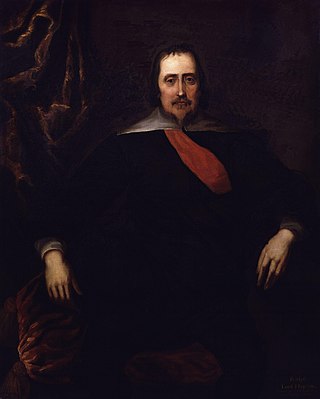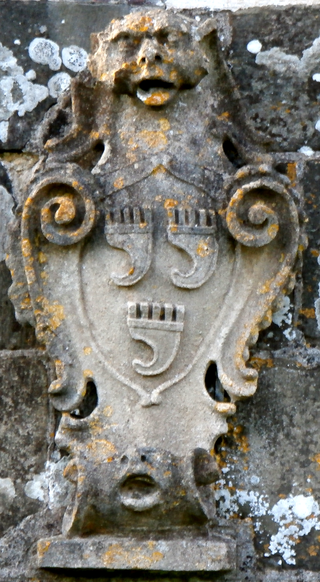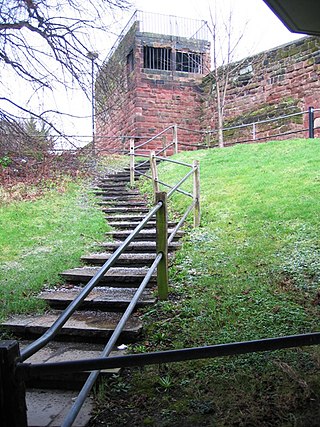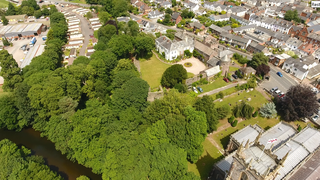Related Research Articles

Ralph Hopton, 1st Baron Hopton was an English politician, military officer and peer. During the First English Civil War, he served as Royalist commander in the West Country, and was made Baron Hopton of Stratton in 1643.

Sir Richard Grenville was a professional soldier from Cornwall, who served in the Thirty Years War, and 1638 to 1651 Wars of the Three Kingdoms. He was the younger brother of Sir Bevil Grenville, who died at Lansdowne in 1643, and grandson of Admiral Sir Richard, killed at Flores in 1591.
This is a timeline of events leading up to, culminating in, and resulting from the English Civil Wars.

The First English Civil War took place in England and Wales from 1642 to 1646, and forms part of the 1639 to 1653 Wars of the Three Kingdoms. An estimated 15% to 20% of adult males in England and Wales served in the military at some point between 1639 and 1653, while around 4% of the total population died from war-related causes. These figures illustrate the widespread impact of the conflict on society, and the bitterness it engendered as a result.

Sir Edward Rossiter was an English landowner, soldier and politician from Lincolnshire. He fought with the Parliamentarian army in the Wars of the Three Kingdoms, and sat as an MP at various times between 1646 and 1660.
Thomas Wentworth, 5th Baron Wentworth, KB, PC was an English landowner and soldier who supported the Royalists during the Wars of the Three Kingdoms. At the end of the First English Civil War in 1646, he accompanied the future Charles II of England into exile and fought with him at the Battle of Worcester in 1651.

The second and longest siege of Worcester took place towards the end of the First English Civil War, when Parliamentary forces under the command of Thomas Rainsborough besieged the city of Worcester, accepting the capitulation of the Royalist defenders on 22 July. The next day the Royalists formally surrendered possession of the city and the Parliamentarians entered Worcester 63 days after the siege began.

The Battle of Stow-on-the-Wold took place during the First English Civil War. It was a Parliamentarian victory by detachments of the New Model Army over the last Royalist field army.
Events from the year 1646 in England. This is the fifth and last year of the First English Civil War, fought between Roundheads (Parliamentarians) and Cavaliers.

Cornwall played a significant role in the English Civil War, being a Royalist enclave in the generally Parliamentarian south-west.
1643 was the second year of the First English Civil War. Politically, the latter months of the year were the turning-point of the war. The King made a truce with the Irish rebels on 15 September which united against him nearly every class in Protestant England. Only ten days after the "Irish Cessation," Parliament at Westminster swore to the Solemn League and Covenant, and the die was cast.
1644 was the third year of the First English Civil War. The King's position continued to decline and the Long Parliament sent the Propositions of Uxbridge, an attempt to end the war, to the king at Oxford
1645 was the fourth year of the First English Civil War. By the beginning of 1645 the war was going badly for Charles I and the campaigns of 1645 did not see a recovery in his prospects.

Worcestershire was the county where the first battle and last battle of the English Civil War took place. The first battle, the Battle of Powick Bridge, fought on 23 September 1642, was a cavalry skirmish and a victory for the Royalists (Cavaliers). The final battle, the battle of Worcester, fought on 3 September 1651, was decisive and ended the war with a Parliamentary (Roundhead) victory and King Charles II a wanted fugitive.

The siege of Chester occurred over a 16-month period between September 1644 and February 1646 during the First English Civil War. In the engagement, Sir William Brereton and the Parliamentarians were ultimately successful in taking possession of the city and Royalist garrison commanded by Lord Byron.
Colonel Sir Gilbert Gerard was a Royalist officer during the English Civil War.

The siege of Lichfield occurred on 8–21 April 1643 during the First English Civil War. During the military action, the Royalists under the command of Prince Rupert successfully besieged the Parliamentary garrison of Lichfield in Staffordshire under the command of Colonel Russell.
The battle of Bovey Heath took place on 9 January 1646 at Bovey Tracey and Bovey Heath during the First English Civil War. A Parliamentarian cavalry detachment under the command of Oliver Cromwell surprised and routed the Lord Wentworth's Royalist camp.

The Siege of Tiverton took place in October 1645 during the First English Civil War, when a Royalist garrison surrendered to a detachment of the New Model Army.

The siege of Hereford took place in 1645 during the English Civil War when the city of Hereford and its English Royalist garrison was besieged by a Scottish Covenanter army under the command of the Earl of Leven. The Covenanters were allied to the English Parliamentarian cause and moved to take the Royalist stronghold in the wake of their victory at the Battle of Naseby. After a month-long siege the approach of Royalist reinforcements and news of Montrose's victories against the Coventanters in Scotland forced Leven to abandon the siege and retreat. However, in December of the same year the city was taken in a surprise attack by Colonel John Birch and remained in Parliamentarian hands for the remainder of the conflict.
References
- Willis-Bund, John William (1905), The Civil War In Worcestershire, 1642–1646: And the Scotch Invasion Of 1651, Birmingham: The Midland Educational Company, pp. 175–178, 180–195
- Manganiello, Stephen C. (2004), The Concise Encyclopedia of the Revolutions and Wars of England, Scotland, and Ireland, 1639–1660, Scarecrow Press, p. 378, ISBN 978-0-8108-5100-9
- Varley, Frederick John (1932), The Siege of Oxford: An Account of Oxford during the Civil War, 1642–1646, Oxford University Press
- Wheeler, James Scott (2003), The Irish and British Wars, 1637–1654: Triumph, Tragedy, and Failure, Routledge, p. 156, ISBN 1-134-59832-7
Attribution:
- This article incorporates text from a publication now in the public domain : Atkinson, Charles Francis (1911). "Great Rebellion". In Chisholm, Hugh (ed.). Encyclopædia Britannica . Vol. 12 (11th ed.). Cambridge University Press. pp. 403–421.
| ← 1645 | First English Civil War | Second Civil War → |